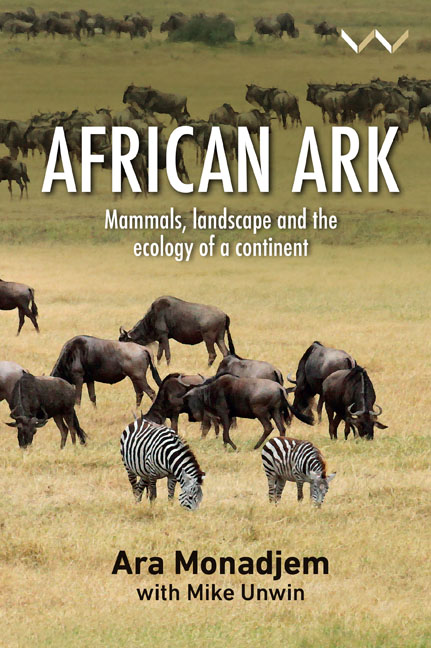Book contents
- Frontmatter
- Dedication
- Contents
- List of Plate Photographs
- List of Figures and Tables
- Acknowledgements
- Foreword
- Preface
- Chapter 1 A Continent of Plenty
- Chapter 2 The Species Conundrum
- Chapter 3 The History of Africa’s Mammals
- Chapter 4 Islands as Species Factories
- Chapter 5 Evolution on the African Mainland
- Chapter 6 Giant Mammals Shaping the Landscape
- Chapter 7 A Place for Every Species
- Chapter 8 Fluctuating Populations
- Chapter 9 The Human Factor
- Chapter 10 The Sinking Ark?
- Glossary
- Notes
- References
- Recommended Reading
- Index
Chapter 1 - A Continent of Plenty
Published online by Cambridge University Press: 29 November 2023
- Frontmatter
- Dedication
- Contents
- List of Plate Photographs
- List of Figures and Tables
- Acknowledgements
- Foreword
- Preface
- Chapter 1 A Continent of Plenty
- Chapter 2 The Species Conundrum
- Chapter 3 The History of Africa’s Mammals
- Chapter 4 Islands as Species Factories
- Chapter 5 Evolution on the African Mainland
- Chapter 6 Giant Mammals Shaping the Landscape
- Chapter 7 A Place for Every Species
- Chapter 8 Fluctuating Populations
- Chapter 9 The Human Factor
- Chapter 10 The Sinking Ark?
- Glossary
- Notes
- References
- Recommended Reading
- Index
Summary
Africa is home to an impressively diverse array of lifeforms. These, in turn, have generated some of the world's most spectacular ecosystems. On a large scale, many need little introduction. Imagine herds of antelope and zebra migrating across Tanzania's Serengeti grasslands, tailed by lions and other predators. Picture the wealth of bird life in the wetlands of Botswana's Okavango Delta; the profusion of colourful fish on a coral reef off the coast of Mozambique; the uniquely adapted plants thriving on the rugged peaks of the Ethiopian highlands. On a smaller scale, peer into any patch of vegetation and you will find a multitude of insects and spiders. Lift a rock and you will probably discover centipedes, millipedes and perhaps a scorpion. Walk past a puddle at night and you may hear a cacophony of male frogs calling out to mates.
Much of this diversity will be unfamiliar, however. Not just to you, but to experts too. Did you know, for example, that there are more than 100 species of shrew in the genus Crocidura, making this the most diverse mammalian genus in Africa? Were you aware that the continent is home to two species of elephant and four species of giraffe? Have you heard of the angwantibo? Or the three aquatic species of otter-shrew? Or the African ‘flying squirrels’, more correctly known as anomalures? These are just a few examples from an animal group usually considered well known: the mammals.
As these examples suggest, Africa's fauna is both diverse and relatively little known. But how diverse, exactly? And how does Africa's diversity compare with that of other continents? These are the questions that this chapter aims to answer.
SPECIES RICHNESS IN AFRICA
Let us ask a simple question: how many mammal species occur in Africa? Of course, we could ask the same question about birds, reptiles, spiders, grasses or any other group of organisms. Although such a question appears to be simple, in practice it is not so easily answered. In fact, it may surprise you to discover that we don't actually know the answer.
Perhaps rephrasing the question would help – and, at the same time, offer a little more insight into the issue. We could, instead, ask how many species of African mammal have been formally described by scientists. This is slightly easier to answer but still requires some discussion. What do we mean by ‘Africa’?
- Type
- Chapter
- Information
- African ArkMammals, Landscape and the Ecology of a Continent, pp. 5 - 36Publisher: Wits University PressPrint publication year: 2023



